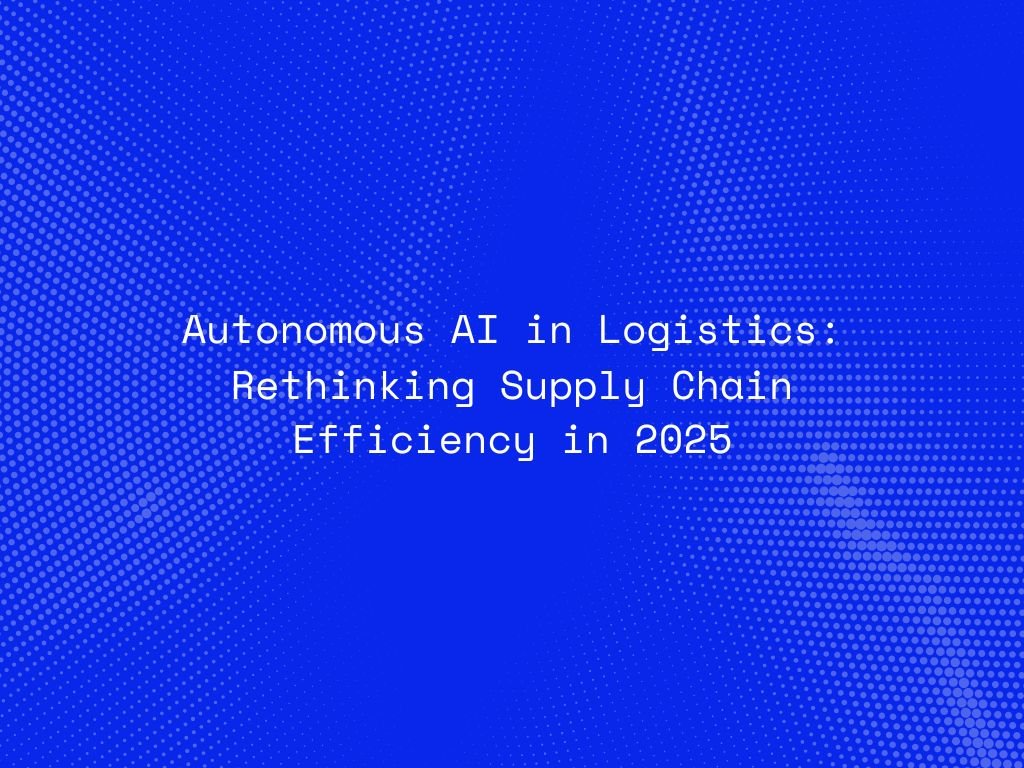In the increasingly dynamic world of global commerce, logistics is no longer just a back-end function—it’s a strategic differentiator. And in 2025, one key force is revolutionizing it: autonomous AI. From warehouse automation and delivery drones to real-time routing and predictive inventory, AI is not just optimizing logistics—it’s rethinking how the entire supply chain operates.
What once required manual coordination, human oversight, and reactive planning is now being handled by intelligent, self-learning systems. These AI-powered agents are capable of making decisions on the fly, responding to disruptions instantly, and continuously learning from data across the value chain.
Let’s explore how autonomous AI is driving the future of logistics and why it’s become an operational imperative for companies aiming to stay competitive.
What Is Autonomous AI in Logistics?
Autonomous AI refers to self-operating systems that can perceive their environment, make decisions, and act without constant human intervention. In logistics, this spans across:
-
Self-driving vehicles and drones
-
AI-driven warehouse robots
-
Autonomous planning and scheduling software
-
Predictive demand forecasting
-
Smart inventory management
-
Dynamic routing and real-time decision-making
These technologies work in concert, often orchestrated by multi-agent systems and supported by vast volumes of structured and unstructured data.
Key Areas Where Autonomous AI Is Reshaping Logistics
1. Smart Warehousing and Fulfillment
In modern warehouses, autonomous AI systems are optimizing everything from storage to shipment:
-
Robotic picking and packing powered by computer vision and AI navigation
-
Real-time inventory tracking with sensors and predictive restocking
-
AI-coordinated workforce scheduling to match shifts with workload
AI algorithms reduce errors, minimize downtime, and ensure just-in-time fulfillment—especially critical for e-commerce and retail.
2. Autonomous Transportation and Fleet Management
Self-driving delivery trucks and drones are no longer science fiction—they’re in active deployment and testing:
-
AI systems plan optimal delivery routes based on traffic, weather, and fuel efficiency
-
Autonomous vehicles operate in controlled environments like ports and warehouses
-
AI monitors fleet health and predicts maintenance to prevent breakdowns
The result is lower operating costs, faster delivery windows, and reduced carbon emissions.
3. Predictive and Adaptive Supply Chain Planning
Traditional logistics operated on static forecasts. Autonomous AI systems bring real-time adaptability:
-
Predictive analytics forecast demand, identify delays, and allocate resources dynamically
-
AI systems analyze variables like geopolitical events, weather, or consumer sentiment
-
Digital twins simulate the entire supply chain to stress-test decisions before implementation
This means businesses can plan proactively and respond instantly to market changes.
4. Intelligent Inventory Optimization
Excess inventory ties up capital; stockouts lose customers. AI systems strike a balance by:
-
Forecasting demand by SKU, region, and season
-
Recommending procurement and reordering strategies
-
Suggesting distribution center adjustments to reduce shipping costs
AI doesn’t just count inventory—it learns how it moves, where it slows, and how to optimize the flow.
5. Risk Mitigation and Resilience Building
Supply chains are exposed to increasing risks—pandemics, climate disasters, geopolitical tension. Autonomous AI systems can:
-
Detect early warning signs through pattern recognition
-
Recommend alternate suppliers, routes, or partners
-
Evaluate the financial and operational impact of disruptions in real time
AI enables supply chains to be proactive rather than reactive.
Benefits of Autonomous AI in Logistics
-
Operational Efficiency: Reduce human error, lower costs, and optimize time
-
Real-Time Decision Making: Respond instantly to new information or disruption
-
Improved Customer Satisfaction: Faster deliveries and more accurate order fulfillment
-
Scalability: AI systems handle increased complexity and volume with ease
-
Sustainability: Smarter route planning and energy-efficient warehousing reduce emissions
Challenges to Adoption
Despite its promise, deploying autonomous AI in logistics isn’t without hurdles:
-
Integration with legacy systems can be complex
-
Data quality and availability must be ensured for effective AI training
-
Workforce adaptation and reskilling are needed to align human roles with AI
-
Cybersecurity risks increase as supply chains become more digitized and automated
-
Regulatory concerns around autonomous vehicles and AI decision-making
Overcoming these challenges requires strategic investment, cultural change, and strong leadership alignment.
The Road Ahead: A Fully Autonomous Supply Chain
By the end of this decade, the most advanced companies will operate near-autonomous supply chains where:
-
AI agents coordinate shipments, purchasing, and capacity without manual input
-
Warehouses run with minimal human supervision
-
Delivery is handled end-to-end by drones or autonomous trucks
-
Sustainability goals are met with real-time emissions tracking and smart resource allocation
These capabilities won’t just be limited to large enterprises—mid-sized and even small businesses will access AI logistics tools through APIs, cloud platforms, and modular SaaS systems.
Conclusion
In 2025, logistics leaders are no longer asking if they should adopt AI, but how fast they can implement it. The rise of autonomous AI in logistics marks a turning point in supply chain history—where intelligent systems are driving not just optimization, but innovation.
Organizations that embrace this shift will gain unparalleled visibility, agility, and efficiency, positioning themselves for long-term success in a world defined by speed, complexity, and uncertainty.




